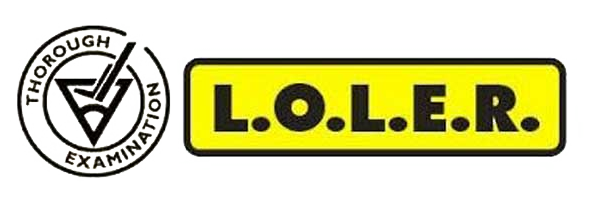
These Regulations (often abbreviated to LOLER) place duties on people and companies who own, operate or have control over lifting equipment. This includes all businesses and organisations whose employees use lifting equipment, whether owned by them or not. In most cases, lifting equipment is also work equipment so the Provision and Use of Work Equipment Regulations (PUWER) will also apply (including inspection and maintenance). All lifting operations involving lifting equipment must be properly planned by a competent person, appropriately supervised and carried out in a safe manner.
LOLER also requires that all equipment used for lifting is fit for purpose, appropriate for the task, suitably marked and, in many cases, subject to statutory periodic 'thorough examination'. Records must be kept of all thorough examinations and any defects found must be reported to both the person responsible for the equipment and the relevant enforcing authority.
How the Lifting Operations and Lifting Equipment Regulations apply to health and social care
The Lifting Operation and Lifting Equipment Regulations1998 (LOLER) are aimed at ensuring that; ‘all lifting operations are properly planned, lifting equipment is used in a safe manner and that, where necessary, it is thoroughly examined at suitable intervals by a competent person’.
LOLER of course covers all equipment that is designed to lift or lower a load (as its principle function), such as cranes, forklift trucks etc that are used in the workplace, but in the healthcare industry it is those pieces of equipment that are designed to lift people that are of most interest.
LOLER in Health and Social Care
In December 2012, the HSE published a guidance document in order to clarify questions raised by those responsible for lifting equipment in healthcare settings. It’s worth noting here that LOLER covers new, used as well as leased equipment.
Whose responsibility?
If you are an employer providing equipment for people at work or you have control of work equipment it is your responsibility to ensure that the LOLER regulations are adhered to, so you can see why this is a topic of interest for Community Equipment Managers and employers in the Domiciliary and Residential Care sector.
The aim of LOLER
The aim of LOLER is to reduce risk. This reduction of risk of course underpins most of the moving and handling activities that are carried out in healthcare settings, and most will be familiar with and understand the rationale for proper and documented risk assessment. Indeed, one of the key questions asked in negligence claims are. Was a risk assessment carried out? What was done to reduce risk? Was it documented?
What needs to be done?
Ensure lifting operations are planned, that equipment is used in a safe manner, and is suitable for intended use
Ensure that equipment is strong and stable and is marked according to workload
Equipment must be examined by a competent person at suitable intervals
For LOLER to be relevant the key question to ask is… Is it ‘work equipment’?
This is defined in another HSE regulation - The Provision and Use of Work Equipment Regulations 1998 or (PUWER) as ‘any machinery appliance, apparatus, tool or installation for use at work (whether exclusively or not)’.
What healthcare equipment is covered by LOLER?
Mobile Patient Lifters
Stand Assist Lifters
Overhead Hoists
Bath Lifters
Bath Hoists
Lifting Platforms
Stair Lifts
Accessories - e.g. slings, spreader bars
You will recall earlier in the article the mention of principle function. For example, an electric profiling care bed, whilst designed to raise and lower, its principle function is to be a bed, so therefore does not require six monthly LOLER testing.
Bear in mind however, if the equipment is not lifting equipment, but is used as a piece of work equipment it will still be covered under PUWER. PUWER requires that all work equipment be maintained in an efficient state, in efficient order and in good repair.
Is it work equipment?
Let’s take the example of a bath lifter. This was a topic that was discussed widely at the recent National Association of Equipment Providers exhibition.
One can argue, a bath lifter provided solely for the use of a service user does not come under LOLER or even PUWER. However, if a paid carer uses the bath lifter (or any other lifting product) to assist a service user, then it becomes work equipment and is then required under LOLER to be inspected on a six monthly basis.
It should also be noted that the HSE states ‘If the equipment has been loaned by a community equipment store for use solely by individuals, family or unpaid carers, the more general duties under the Health and Safety at work Act 1974 (section 3) apply.
The view on LOLER testing of Bath Lifters across Community Equipment Managers was fragmented, with some taking a stringent approach to safety inspection, which was praised by Anne Reed, Medeagle International Ltd who attended to provide expert advice on what measures can be put in place to ensure duty of care is met.
Who carries out the LOLER inspection?
In the August issue of THIIS, Alistair Gibbs of TPG, discusses the temptation to compromise on quality, and in relation to essential safety inspection this is very relevant.
You have defined that the equipment is indeed lifting equipment, is used by a carer or employee, therefore is work equipment and in accordance with the HSE must be inspected on a six monthly basis by a competent person. You may choose to use:
In house technical personnel
Approved dealer/service agent
HSE definition
A competent person is someone who has sufficient training and experience or knowledge and other qualities that allow them to assist you properly. The level of competence required will depend on the complexity of the situation and the particular help you need.